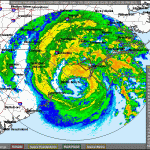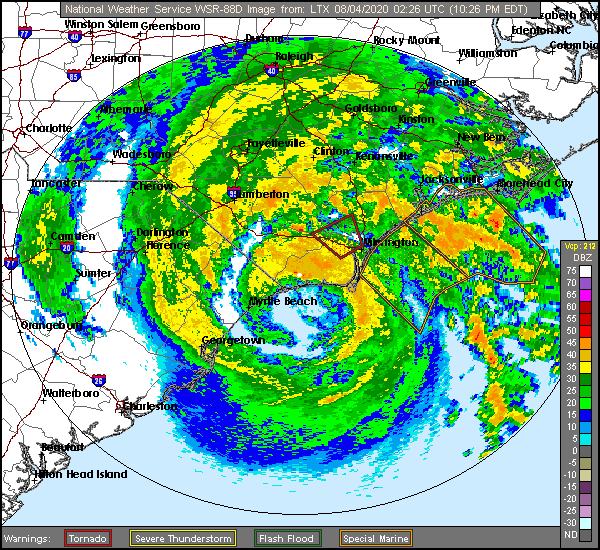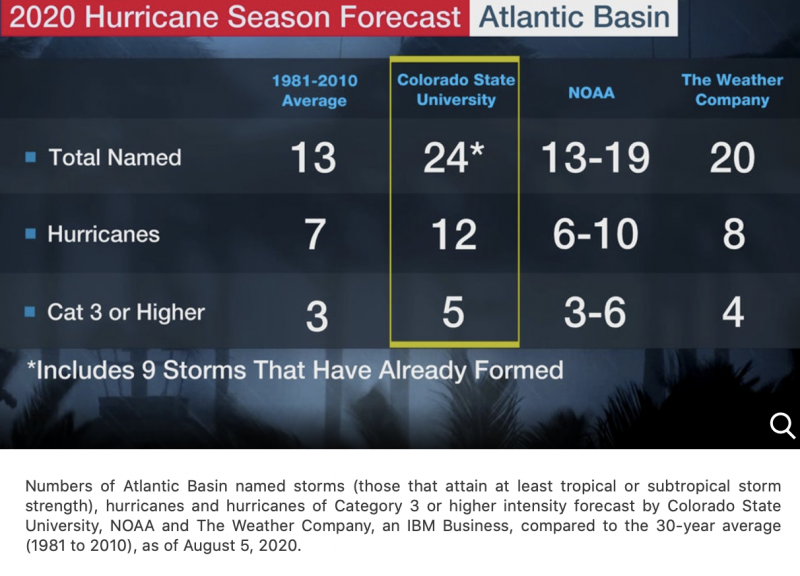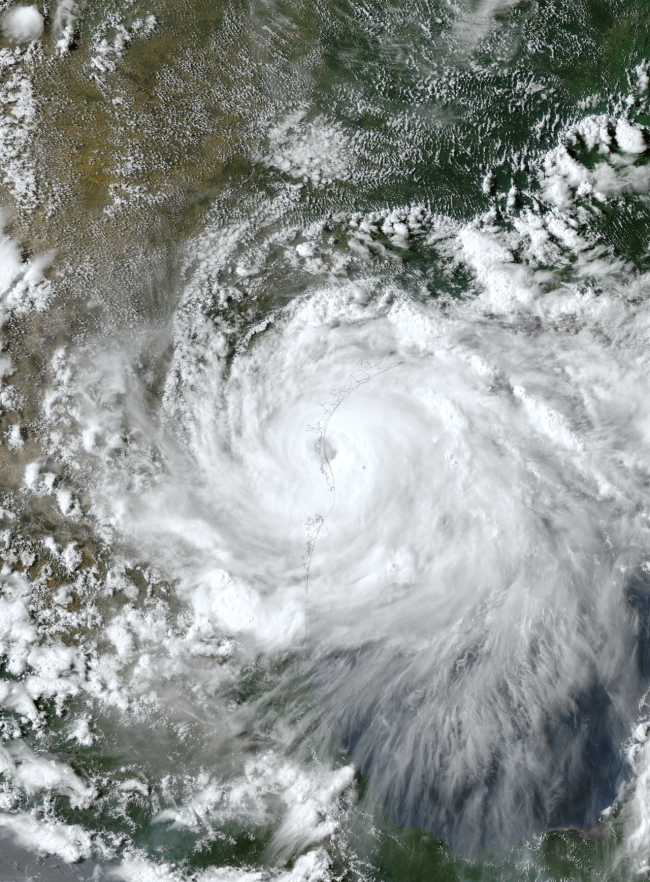

Hurricane Isaias as seen on weather radar, making landfall near Ocean Isle Beach, North Carolina on August 4, 2020. Image via National Weather Service Wilmington/ Wikimedia Commons.
2020 was already predicted as an active hurricane season. Now it’s looking extremely active. Forecasters with Colorado State’s Tropical Meteorology Project said on Wednesday (August 5, 2020) they now expect five major hurricanes and 24 named storms in the 2020 Atlantic hurricane season. That’s an increase from a prediction they made in early July of four major hurricanes and 20 named storms. Meanwhile, from 1981 to 2010, Atlantic hurricanes averaged 12 named storms per year.
What’ll happen if we run out of hurricane names this year? More about that below.
Atlantic hurricane season officially begins on June 1 each year, and most major hurricanes tend to come later in the season. However, in terms of numbers, the season got off to a roaring start this year. 2020 is the first hurricane season on record with nine named storms (two hurricanes) before August 1.
2020’s named tropical storms so far are Arthur, Bertha, Cristobal, Dolly, Edouard, Fay, Gonzalo, Hanna (a hurricane) and Isaias (a hurricane).
All were tropical storms, but Hanna and Isaias had maximum sustained winds strong enough (above 74 mph or 119 kph) to categorize them as hurricanes. Both Hanna and Isaias made landfall in the U.S. Hanna reached its peak intensity with winds at 90 miles per hour (140 km/h) on July 25, the same day it made its first landfall at Padre Island, Texas (Hanna had a second landfall in Kenedy County, Texas, at the same intensity). Isaias had sustained winds of 85 miles per hour (137 km/h) when it made landfall on Ocean Isle Beach, North Carolina, on August 4.
Colorado State’s Tropical Meteorology Project is not the only source of hurricane forecasts. The chart below shows some comparisons.

Chart via Weather.com.
What’ll happen if we run out of hurricane names in 2020? The Atlantic hurricane name list for 2020 contains a total of 21 names: Arthur, Bertha, Cristobal, Dolly, Edouard, Fay, Gonzalo, Hanna, Isaias, Josephine, Kyle, Laura, Marco, Nana, Omar, Paulette, Rene, Sally, Teddy, Vicky, and Wilfred.
If we run through those 21 Atlantic hurricane names, the rule of thumb is that any additional storms receive names from the Greek alphabet. So if we do have a tropical storm Wilfred in 2020, and another storm follows it, that storm will be Alpha. The next storm will be Beta, then Gamma, and so on.
So far, in the history of naming Atlantic hurricanes, we’ve gone to the Greek alphabet only once, in 2005. Remember that? It was the busiest hurricane season on record. There were 28 named storms that year.
Atlantic hurricane season will officially end on November 30; however, hurricanes can and do occur (as they did this year) before the official start of the season on June 1 and after its official end.
Read more: How do hurricanes get their names?

Hurricane Hanna making its first landfall on Padre Island, Texas, on July 25, 2020. Image via NOAA/ Wikimedia Commons.
Bottom line: Forecasters with Colorado State’s Tropical Meteorology Project forecasters said on Wednesday (August 5, 2020) that they now expect five major hurricanes and 24 named storms in the 2020 Atlantic hurricane season.
from EarthSky https://ift.tt/33zr41I


Hurricane Isaias as seen on weather radar, making landfall near Ocean Isle Beach, North Carolina on August 4, 2020. Image via National Weather Service Wilmington/ Wikimedia Commons.
2020 was already predicted as an active hurricane season. Now it’s looking extremely active. Forecasters with Colorado State’s Tropical Meteorology Project said on Wednesday (August 5, 2020) they now expect five major hurricanes and 24 named storms in the 2020 Atlantic hurricane season. That’s an increase from a prediction they made in early July of four major hurricanes and 20 named storms. Meanwhile, from 1981 to 2010, Atlantic hurricanes averaged 12 named storms per year.
What’ll happen if we run out of hurricane names this year? More about that below.
Atlantic hurricane season officially begins on June 1 each year, and most major hurricanes tend to come later in the season. However, in terms of numbers, the season got off to a roaring start this year. 2020 is the first hurricane season on record with nine named storms (two hurricanes) before August 1.
2020’s named tropical storms so far are Arthur, Bertha, Cristobal, Dolly, Edouard, Fay, Gonzalo, Hanna (a hurricane) and Isaias (a hurricane).
All were tropical storms, but Hanna and Isaias had maximum sustained winds strong enough (above 74 mph or 119 kph) to categorize them as hurricanes. Both Hanna and Isaias made landfall in the U.S. Hanna reached its peak intensity with winds at 90 miles per hour (140 km/h) on July 25, the same day it made its first landfall at Padre Island, Texas (Hanna had a second landfall in Kenedy County, Texas, at the same intensity). Isaias had sustained winds of 85 miles per hour (137 km/h) when it made landfall on Ocean Isle Beach, North Carolina, on August 4.
Colorado State’s Tropical Meteorology Project is not the only source of hurricane forecasts. The chart below shows some comparisons.

Chart via Weather.com.
What’ll happen if we run out of hurricane names in 2020? The Atlantic hurricane name list for 2020 contains a total of 21 names: Arthur, Bertha, Cristobal, Dolly, Edouard, Fay, Gonzalo, Hanna, Isaias, Josephine, Kyle, Laura, Marco, Nana, Omar, Paulette, Rene, Sally, Teddy, Vicky, and Wilfred.
If we run through those 21 Atlantic hurricane names, the rule of thumb is that any additional storms receive names from the Greek alphabet. So if we do have a tropical storm Wilfred in 2020, and another storm follows it, that storm will be Alpha. The next storm will be Beta, then Gamma, and so on.
So far, in the history of naming Atlantic hurricanes, we’ve gone to the Greek alphabet only once, in 2005. Remember that? It was the busiest hurricane season on record. There were 28 named storms that year.
Atlantic hurricane season will officially end on November 30; however, hurricanes can and do occur (as they did this year) before the official start of the season on June 1 and after its official end.
Read more: How do hurricanes get their names?

Hurricane Hanna making its first landfall on Padre Island, Texas, on July 25, 2020. Image via NOAA/ Wikimedia Commons.
Bottom line: Forecasters with Colorado State’s Tropical Meteorology Project forecasters said on Wednesday (August 5, 2020) that they now expect five major hurricanes and 24 named storms in the 2020 Atlantic hurricane season.
from EarthSky https://ift.tt/33zr41I

Aucun commentaire:
Enregistrer un commentaire